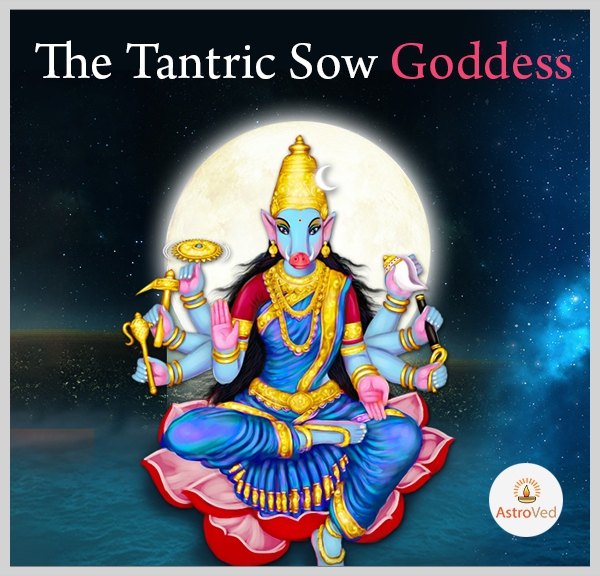The Tantric Sow Goddess
Lord Vishnu is a major male deity in Hinduism along with Lord Shiva and Lord Brahma. Together, they are called the Trimurti. There are ten incarnations or avatars of Vishnu. They are called the Dasavatara. He incarnated whenever the forces of evil threatened to overcome the universe. Each Avatar was for one purpose which was the restoration of Dharma or righteousness.

This is the third avatar of Lord Vishnu. This avatar appeared in the Satya Yug. In this avatar, he came as a Boar to protect the earth. at the time, the demon Hiranyaksha was tormenting everyone on earth as well as the gods. He even made the earth sink to the bottom of the ocean. Finally Lord Vishnu had to intervene in order to kill the demon who had attained the boon of invincibility from Lord Brahma.Vishnu turned into a wild boar or Varaha, plunged into the ocean, defeated Hiranyaksha and lifted the Earth-Goddess on his snout and brought her back to the surface.
Varahi, on the other hand, is one of the Saptamatrika goddesses. They represent the shakti or feminine energy of the male gods. Goddess Varahi is represented as a sow or female pig. She has a black complexion, the head of a sow, a pot belly and full breasts. She also has two to six arms carrying many weapons. They include a noose, a trident, a mace and a discus. Sometimes, she has a child in her arms and she is often portrayed as riding a buffalo. According to one theory, she has a pot belly as she is identified with the Yoganidra of Vishnu. In this form, she has the universe in her womb. Another theory says that the pot-belly suggests a "maternal aspect". But she is depicted as a slender, human-faced figure at the sixth-century Rameshvara cave (Cave 21) of the Ellora Caves. Here too, she is part of the seven Matrikas. There is a third eye and/or a crescent moon on her forehead. It is at night that Varahi is usually worshipped. Offerings to her include fish and the blood of male animals. She does not have a male consort. Hence she is regarded as a Tantrik goddess. The baby in her arms is associated with fertility and the buffalo with death. There aren’t many temples for Goddess Varahi. The more popular ones can be found in Odisha, Chennai, Varanasi and Nepal. The temple dedicated to her in Chaurasi, Odisha, gets offerings from the Jagannatha temple in Puri. This Vaishnava shrine has always enjoyed a close affiliation with Tantrik Shakta goddesses. Shaktas regard Varahi as a manifestation of Goddess Lalita Tripurasundari or as "Dandanayagi", the commander-general of Lalita's army.
The Saptamatrika goddesses form a female collective and appear to help Durga in her fight against Raktabeeja. They are known for drinking the demon’s blood so that he will not be able to reproduce himself. There are seven Matrikas and Varahi is the fifth. Hence, she is called Panchami. An interesting reason lies behind this. The Matrikas are linked to the Devanagari alphabet. The seven Matrikas represent the seven rows of consonants and Varahi represents the fifth, ie. the sounds: pa, pha, ba, bha, ma.
Pigs are seen as dirty in India. They are associated with people who are considered ‘untouchables’ and relegated to the margins of society. Hence, the worship of Varahi can be taken to signify rebellion and subversion. Full moon days are regarded as sacred for Goddess Varahi. Sometimes she is called Dhumavati or Dhruma Varahi.
According to Vaishnava texts, Varahi is the feminine principle of Varaha. Shakta texts say she is the mother of Varaha. People worship Varaha with fruits and milk whereas they worship Varahi with meat, blood and alcohol. Varaha is worshipped during the day but Varahi and the other Matrikas are worshipped at night. One episode of the Devi Mahatmya that recounts the killing of the demon Raktabija holds that the warrior-goddess Durga created the Matrikas from within herself to kill the demon army. When the demon Shumbha demands that Durga face him in single combat, she supposedly absorbed the Matrikas into herself. The Vamana Purana says that the Matrikas emerge from different parts of the Divine Mother Chandika. Varahi is said to emerge from Chandika's back. Those who desire longevity are advised to invoke Goddess Varahi by the Devi Mahatmya.
Nowadays, Hinduism is acquiring a puritanical and regressive slant. Perhaps it is a good time to foreground goddesses like Varahi, who formed part of the Tantra challenge to such puritanical beliefs as she stands for a more realistic attitude towards life, death, sex and violence.



















